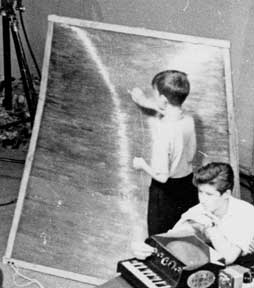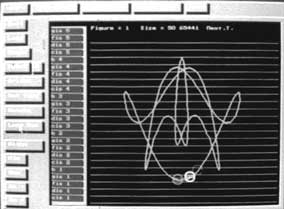MELODY-DRAWING TRANSFORMATION
Bulat M. Galeyev
The theremin allows for the transformation of hand movements
in space into melody. Certain techniques for the transformation
of plane drawings into sound patterns resemble the technology
used by the theremin. Thirty years ago, R. Saifullin and I invented
and built an electro-mechanical device based on these techniques.
Its main component was a large, flat rheostat switched into the
frequency (w) control circuit of an electronic sound generator
(Fig. 1). Vertical displacement of an electric contact with the
rheostat produced a change of the pitch of the sound (Lg(w)), while
horizontal displacement (whether to the left or right) produced
no change in pitch (w = const, here meaning the value of w at a
particular position of rheostat contact along the vertical).
Simple as it was, this device nevertheless revealed an
interesting correlation between aural and visual perception: when
we drew curvilinear shapes (circles, spirals, etc.) on the plane,
listeners were able to describe the shapes formed by the lines
without visually observing the drawing process. Our
experimentation with the device contributed to our research in
the field of aural-visual synaesthesia
[1].
Years later, I have now come to understand how the principles on
which this device was based can also be applied to musical practice
by means of computer technology
[2].
 |
|
Fig. 1. The original Galeyev/Saifullin device for sound
production by means of drawing, as photographed in a television
studio in 1961.
The operator (R. Saifullin, in background) slides
the electric contact along the flat rheostat.
(The person in the foreground is the television camera man.) |
Collaboration with two colleagues experienced in computer
programming (A. Shumilov and D. Piotrovsky) has brought me back to
these ideas after a lapse of many years
[3, 4].
We have created a
software called Computer Brusophon that represents a "sound
field" as a ruled drawing field on a computer display monitor,
with horizontal lines demarcating equally tempered scale
divisions (Fig. 2). The uppermost line in the drawing corresponds
to the highest frequency, while the lowest line corresponds to
the lowest frequency of the sound. Each octave is divided into 12
parts. The software allows for the user to scan a preset drawing
in order to produce a composition (Fig. 2). Alternatively, one
can also draw with the mouse; changes in the curves of the lines
thus produced are simultaneously transformed into changes in
pitch. Thus, one can both transform preset drawings into sound
and also create new sound patterns in real time while drawing.
 |
|
Fig. 2. Screen shot of Computer Brusophon, software for sound
generation by means of drawing, 1992. The contours of the graphic
pattern displayed on the computer monitor are scanned by a
sound-triggering cursor (the white circles on the lower right are
traces left by the cusor as it scans over the line). The buttons
on the upper and left peripheries of the screen correspond to
functions such as switching the sound on and off, activating the
mouse, changing the speed at which the preset drawing is scanned,
choosing the scale of the drawing and rotating the drawing. Notes
corresponding to the lines in the drawing field are designated on
keys to the immediate left of the field |
Our experiments with drawing using this program have not yet
produced patterns of sounds that could be called musical
melodies. With a view toward producing melodies, we have
configured sound fields of particular diatonic (flat, sharp) and
pentatonic scales. This configuration consists of excluding, by
means of programming techniques, any "excess" notes - i.e. those
not used in a particular scale - from the 12 tones of an octave.
The condensed range of tones is graphically represented as a kind
of vertically oriented keyboard appearing to the left of the
drawing field (for example, Fig. 2 shows the sound field of the
pentatonic scale that consists of the tones produced by the black
keys on the traditional piano keyboard). The sound structures
obtained by drawing on such configured sound fields come closer
to resembling melodies (especially - in the case of the
configuration shown in Fig. 2 - the melodies of traditional Tatar
music, which feature relatively smooth transitions between notes
in a pentatonic scale)
[5].
In the case of European music (or,
more precisely, its basic diatonic modes) additional intervals
must be introduced into the condensed keyboard in accordance with
specific rules in order to produce sound patterns resembling
melodies. My colleagues A. Sutchkov and M. Belyalov and I are now
busy solving this problem, in addition to conducting experiments
related to sound-duration control (rhythm), periodical accenting
of sound (meter) and development of the software to produce
harmonic accompaniment as well as melody. For the time being, we
are limiting ourselves to European music of the seventeenth and
eighteenth centuries in order to avoid the problem of
musical-language formalization, which is not an easy one to solve
due to the impossibility of reducing musical languages to simple
uniformity. We plan to use the computer to test an old hypothesis
of mine regarding possible correlations between the melodic and
ornamental structures of the arts of a given culture, in addition
to continuing to develop the current software's potential as a
means for creating and performing music by drawing. We have been
encouraged by the fact that similar experiments are now being
carried out independently by other musicians and researchers (in
Moscow, for example). This has compelled us to continue our own
research and experimentation and to begin to compile an
international collection of articles on the subject for
publication under the title "Melody-Drawing Transformation."
Acknowledgments
This research is being carried out under the auspices of the
Academy of Sciences of Tatarstan and is supported by the Russian
Humanitarian Foundation.
References
- B. Galeyev. "Device for Spatial-Audio Synaesthesia
Investigations". In: Materials of the Third "Light and Music"
Conference (Kazan, Russia: KAI, 1975). [In Russian.]
- B. Galeyev. "Creating Musical Compositions by Drawing". In:
Electronic Technology and Art (abstracts) (Novosibirsk, Russia:
NGK, 1990). [In Russian.]
- B. Galeyev, D. Piotrovsky and A. Shumilov.
"Applying Computer Graphics to the Simulation of Melodic Patterns," Novosti
iskusstvennogo Intellekta (special issue) (1995). [In Russian.]
- D. Piotrovsky. "Computer Graphic Modeling of Melodic
Structures," New Technologies in Culture and Art: A Regional
Scientific-Practical Seminar (abstracts) (Kazan, Russia: ANT,
1995). [In Russian.]
- B. Galeyev, D. Piotrovsky and A. Shumilov. "Graphical
Simulation of Pentatonic Music," Pentatonics in the Context of
World Musical Culture (materials from 1993 conference) (Kazan:
KGK, 1993). [In Russian.]
Published in "Leonardo
music journal", 1996, Vo.6, pp.61-62

